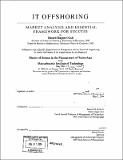| dc.contributor.advisor | Edward B. Roberts. | en_US |
| dc.contributor.author | Huguet i Galí, Ricard, 1970- | en_US |
| dc.contributor.other | Massachusetts Institute of Technology. Management of Technology Program. | en_US |
| dc.date.accessioned | 2005-06-02T18:59:38Z | |
| dc.date.available | 2005-06-02T18:59:38Z | |
| dc.date.copyright | 2004 | en_US |
| dc.date.issued | 2004 | en_US |
| dc.identifier.uri | http://hdl.handle.net/1721.1/17869 | |
| dc.description | Thesis (S.M.M.O.T.)--Massachusetts Institute of Technology, Sloan School of Management, Management of Technology Program, 2004. | en_US |
| dc.description | Includes bibliographical references (leaves 84-87). | en_US |
| dc.description.abstract | IT offshoring is the practice of acquiring Information Technology capabilities, usually from an outsourcing service, but also through company-owned, dedicated centers, in remote lower-cost locations. The goal of this thesis is to develop a strategic framework to help companies succeed in the offshoring process. The framework assesses the five essential factors: strategic factors, to check the proper alignment of the off shoring venture with the overall company strategy; internal factors, to check the readiness of the organization; as well as operational factors, to assess the implementation part of the offshoring project. To evaluate the whole process, some metrics such as productivity, quality and flexibility are proposed (outcome factors). Finally, the framework assesses some contextual factors that influence companies before, during and after they decide to offshore. Based on Michael Porter's five-forces model, the industry analysis indicate that customers have the most power in the industry and vendors have little pricing power due to low barriers of entry and exit. Despite the fact that it is a growing industry, there is a high level of rivalry and it is not attractive. The market demand and supply analysis focused on the larger players showed that India, China, Russia and Eastern Europe are providing the bulk of the contracted services originally performed in the U.S. and U.K. The latest trends in the market are the shifting roles of the agents, the role customers take of being vendors and building their captive centers, the industry consolidation for companies to achieve scale and organize the market, and the need of the vendor to provide broader services such as BPO (Business Process Outsourcing) to better serve their customers. It is exhilarating to be able to spot opportunities both in the supply and demand side. Winners will be the ones who benefit the most from the industry changes, and they will also be the ones who are able to capture most of the value created by the industry as a whole. | en_US |
| dc.description.statementofresponsibility | by Ricard Huguet i Galí. | en_US |
| dc.format.extent | 88 leaves | en_US |
| dc.format.extent | 4337865 bytes | |
| dc.format.extent | 4346049 bytes | |
| dc.format.mimetype | application/pdf | |
| dc.format.mimetype | application/pdf | |
| dc.language.iso | eng | en_US |
| dc.publisher | Massachusetts Institute of Technology | en_US |
| dc.rights | M.I.T. theses are protected by copyright. They may be viewed from this source for any purpose, but reproduction or distribution in any format is prohibited without written permission. See provided URL for inquiries about permission. | en_US |
| dc.rights.uri | http://dspace.mit.edu/handle/1721.1/7582 | |
| dc.subject | Management of Technology Program. | en_US |
| dc.title | IT offshoring : market analysis and essential framework for success | en_US |
| dc.title.alternative | Information Technology offshoring : market analysis and essential framework for success | en_US |
| dc.type | Thesis | en_US |
| dc.description.degree | S.M.M.O.T. | en_US |
| dc.contributor.department | Management of Technology Program. | en_US |
| dc.contributor.department | Sloan School of Management | |
| dc.identifier.oclc | 56611849 | en_US |
